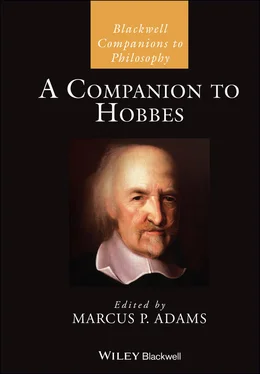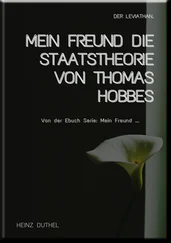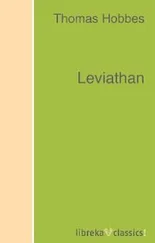Consider two passages. The first is Diogenes Laertius’ gloss of the role of God in Stoic physics:
They believe there are two principles of the universe, the active and the passive. The passive is unqualified substance, i.e., matter, the active is the rational principle (logos) in it. i.e., God … In the beginning he was by himself and turned all substances into water via air and just as the seed is contained in the seminal fluid so this being the spermatic principle of the cosmos remains like this in the cosmos and makes the matter easy for itself to work with in the generation of subsequent things.
(Diogenes Laertius Lives of the Philosophers Bk. 7, 134; LS 1987, 268–9, 275) 23
The second is Hobbes’s (1662) account of his corporeal God’s operation in the world:
I have seen, and so have many others, two waters, one of the river and the other mineral water, so that no man could discern one from the other from his sight; yet when they are both put together the whole substance could not be distinguished from milk. How then could the change be made in every part, but only by the activity of the mineral water, changing it everywhere to the sense and yet not being everywhere and in every part of the water. If such gross bodies have such great activity what then can we think of spirits, whose kinds be as many as there are kinds of liquor, and activity greater? Can it then be doubted that God, who is infinitely fine spirit, and withal intelligence, can make and change all species and kinds of bodies as he pleaseth?
(EW IV.310)
The parallels between these passages are striking: (i) each makes God a special kind of corporeal substance that produces the diversity among familiar bodies by acting on passive and homogenous matter; (ii) each says the divine body operates by thoroughly pervading ordinary matter (though Hobbes denies this involves complete mixing); (iii) each conceives of the divine body as intelligent. I maintain this similarity is no accident: Hobbes adapted his corporeal God from Stoic sources.
Two aspects of the parallel are worth emphasizing. First, consistent with tradition, Hobbes and the Stoics both trace the source of change and diversity to the continuous and ubiquitous activity of God on something like prime matter (OL I.105; EW I.118). 24However, departing radically from tradition, they both hold that God acts on matter by direct contact and local motion. On the Stoics’ biological metaphor, God acts like the seed in seminal fluid; on Hobbes’s chemical metaphor, God is the catalyst in a cosmic cocktail. But in order to avoid a regress, the Stoics and Hobbes both insist that the corporeal God must be in some sense inherently active: a sort of fiery air ( pneuma ) for the Stoics, an infinitely subtle fluid or spirit for Hobbes (Alexander, on Mixture III, 216, 14–20, T 115, LS 1987, 290; OL I.340; EW I.417). Hobbes signals to Bramhall his debt to the Stoic tradition, on this point, noting that “spirit” in Latin signifies “breadth, air, wind” and “in Greek πνεῦμα ( pneuma )” (EW IV.309; see also 2012, 612; 1651, 303). 25
A second important parallel is the common fixation on mixing. Hobbes emphasizes that God pervades ordinary matter though it is impossible they fully mix “unless two bodies can be in the same place” (EW IV.309–10). In Stoic physics the admixture of distinct bodies, particularly God and matter, is hotly debated but generally admitted. 26Hobbes embraces the Stoic theology but follows more orthodox thinkers like Aristotle in opposing strict co-location. His opposition to full mixing is based on his austere geometrical or Cartesian view of extension, which makes the co-extension of distinct bodies impossible. What is most noteworthy for us is that Hobbes even bothers to engage this esoteric and antiquated debate about mixing. This betrays his sympathy for the Stoic materialist program, inside and out. 27
A recent commentator has astutely observed that Hobbes’s expansive philosophy of “accidents” like space, time, and causality, always seem to involve “a curious two-fold description of our ideas” (Leijenhorst 2002, 107). In the case of causality, for example, Hobbes indicates he is concerned primarily with the accidents of bodies considered subjectively, i.e., “that faculty of any body by which it works in us a conception of itself” (EW VIII.103; see Leijenhorst 2002, 157). But he is also concerned with real causal connections. A similar and parallel dual-aspect is evident in the case of both space and time. But, as we have seen above, wholesale subjectivism about space and time cannot support Hobbes’s – or the Stoics’ – cherished and ambitious program in mechanistic science. God, of course, is not an accident; but like the “incorporeals,” space, time, and causality, it is difficult to find a place for the traditional attributes of a transcendent God within a thoroughly materialist and mechanist cosmology. My suggestion is that we can better understand Hobbes’s curious “twofold” metaphysics if we align his project with the overarching worldview originating at the Stoa of Athens.
1 1 See also Leviathan XVI (2012, 244; 1651, 155), Leviathan XXIV (2012, 388; 1651, 190).
2 2 Thomas Stanley’s influential History of Philosophy, devoted many chapters to Stoicism, including chapters on the corporeal God, the void and time (see Stanley 1655–1660, Vol. II, Part 8, 115–19, 123–4).
3 3 De anima v (1885, 185): “The soul certainly sympathizes with the body, and shares in its pain, whenever it is injured by bruises, and wounds, and sores: the body, too, suffers with the soul, and is united with it (whenever it is afflicted with anxiety, distress, or love).” See also De anima vii (1885, 187).
4 4 As with finite souls, Tertullian emphasizes the Stoic objection to dualism that an incorporeal substance cannot act on body. See Evans (1948, 234–7) for discussion of the Stoic background to these texts. On Hobbes’s appeal to these texts in support of materialism, see Riverso (1991, 92).
5 5 For example, in the tract against yet another heretic, Hermogenes, Tertullian invokes with sympathy the Stoic model of God’s mixture with matter: “The Stoics maintained that God pervaded matter, just as honey the honeycomb” (Ad Hermogenes xliv; 1885, 501). Hobbes hints at a closer reading of Tertullian in the Answer to Bramhall, mentioning that De carne Christi is “now extant among his other works” (EW IV.307).
6 6 See Saunders (1955). While in exile, the Cavendishes occupied the former residence of Peter Paul Rubens, who was sympathetic to Stoicism and whose brother, Philip, was a follower of Lipsius. See O’Neill’s Introduction to Cavendish (2001, xiv). On the Rubens’ involvement in the Neo-Stoic circle at Antwerp, see Morford (1991).
7 7 “Discourse of Liberty and Necessity”, section xviii (Bramhall 1842–1844, IV, 116). See also “Defence of True Liberty” (Bramhall 1842–1844, IV, 119). In his Introduction to the defence or “vindication,” Bramhall labels Hobbes’s position “sublimated stoicism” (EW IV.20).
8 8 It is not surprising that the vitalist Cavendish objected to Hobbes’s principle in Leviathan II that “when a thing lies still, unless somewhat else stirs it, will lie still forever” (2012, 26; 1651, 13. cf. De corpore; EW I.115; OL I.102) because it seems to make self-motion impossible (Cavendish 1664, 21). Hobbes’s corporeal God doctrine was not yet formulated.
9 9 On Cavendish’s concerns viz. the foundations of natural philosophy, see Clucas (1994), James (1999), Detlefson (2006), and Sarasohn (2010).
10 10 “In any part of space in which motion is made three times may be considered: past, present and future” (OL I.176; EW 204; see also OL I.98; EW I.110–11).
Читать дальше












